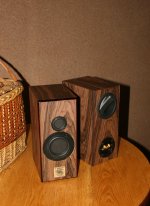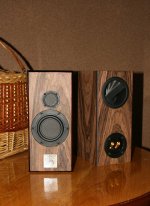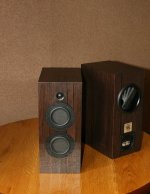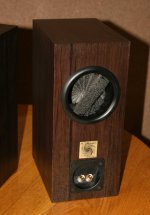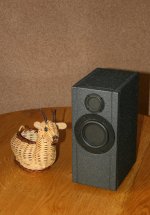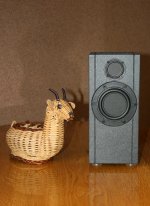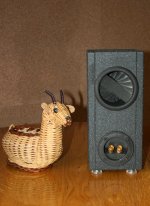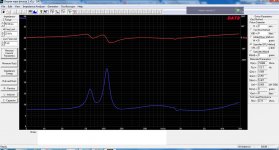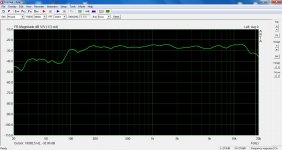Took apart a Hi wave BMR and it is almost exactly like a exciter.....The only difference is the part to attach it to the radiating surface is a very thin aluminum instead of the thick plastic like the normal exciters use....that thin aluminum does not look strong enough to support the weight of a bigger radiating surface or heavier materials or even the drivers own weight without any type of support.
Another one new BMR speakers model: Tectonic Elements TEBM65C20F-8 + Tectonic Elements TEBM35C10-4
Those are some nice looking BMR speakers, did you use a crossover?
Of course I did 🙂Those are some nice looking BMR speakers, did you use a crossover?
I am going to build one using the 2" Hi wave bmrs that I bought. Going to use 2 of them with one of them in a ported enclosure running full range while the second one will be on top in a open baffle with a 20 uf capacitor for the highs sort of mimicking the Nola Brio Trios speakers. Plus I will also be using a wave guide for the top driver.
Another one new BMR speakers model: Tectonic Elements TEBM65C20F-8 + Tectonic Elements TEBM35C10-4
How do you like the sound from the 2 inch driver? Have you listened to it by itself?
Why did you choose a crossover frequency of 2kHz? The 2 inch driver looks to have a much smoother frequency response (although it is 1/3 octave smoothed) than the 3.5 inch driver that has a huge 10dB dip around 1900Hz (>5dB from about 1700-2100Hz) for the 3.5 inch driver. Seems like you could easily use a crossover frequency below 1kHz and out of the critical range.
How do you like the sound from the 2 inch driver? Have you listened to it by itself?
Why did you choose a crossover frequency of 2kHz? The 2 inch driver looks to have a much smoother frequency response (although it is 1/3 octave smoothed) than the 3.5 inch driver that has a huge 10dB dip around 1900Hz (>5dB from about 1700-2100Hz) for the 3.5 inch driver. Seems like you could easily use a crossover frequency below 1kHz and out of the critical range.
The sound of a 2 inch driver is typical for BMR: saturated, dense and smooth. 2 kHz was chosen not by chance:
The first goal is to give the maximum possible bandwidth to the 2 inch driver, because it has a smoother response. The second goal is to try to improve the frequency response in the region of 1700-2100HZ. For this, I chose a serial filter type and the result met expectations.
The first goal is to give the maximum possible bandwidth to the 2 inch driver, because it has a smoother response. The second goal is to try to improve the frequency response in the region of 1700-2100HZ. For this, I chose a serial filter type and the result met expectations.
That's what I meant, why don't you crossover at a lower frequency to let the 2 inch driver handle more of the spectrum? From the frequency response plots it looks like you could cross over down to 300Hz with good results! Of course, these won't be able to play that loud given the 10W power handling and low linear xmax (8mm quoted xmech) of the 2 inch driver.
That's what I meant, why don't you crossover at a lower frequency to let the 2 inch driver handle more of the spectrum? From the frequency response plots it looks like you could cross over down to 300Hz with good results! Of course, these won't be able to play that loud given the 10W power handling and low linear xmax (8mm quoted xmech) of the 2 inch driver.
I'll try and compare sound with second pair of the same type of speakers. To be continued... 😎
IMO Majority of all the exciters have very high output in the mid range frequencies which seems to over power the treble....by crossing over the 2"bmr at 1khz and over seems to decrease the high out put of midrange while increasing the treble.....Crossing it at 300hz will just have too much midrange out put and not enough treble....Personally I would not cross it over lower then 800hz. and prefer it in the 1khz and above.
The small black bookshelfs are looking really interesting. I'm curious what type of crossover topology you are using. Third order for both or do you have a more simple solution?
Interesting. I built simple tapered transmissionline-speakers with two BMR65 per side and i'm thinking about an upgrade with a BMR35 for the upper mid/high range.
Actually i'm using them only for my small "hometheatre" but they can play much more.
I will take your parameteres as a starting point for my own simulations and see how i will end up.
Had a look on your builds again and i really like what you are doing and also that you are experimenting with these tornado enclosures. Keep on going 🙂
Actually i'm using them only for my small "hometheatre" but they can play much more.
I will take your parameteres as a starting point for my own simulations and see how i will end up.
Had a look on your builds again and i really like what you are doing and also that you are experimenting with these tornado enclosures. Keep on going 🙂
Had a look on your builds again and i really like what you are doing and also that you are experimenting with these tornado enclosures. Keep on going 🙂
Thank you. I have been experimenting for more than five years and yet from time to time new discoveries happen 🙂
I just noticed the foam in the port tubes positioned to form a double helix. What's the logic behind that besides splitting the port volume in two and making the effective path length longer?
Edit: technically I guess it is called a helicoid - https://en.wikipedia.org/wiki/Helicoid
Edit: technically I guess it is called a helicoid - https://en.wikipedia.org/wiki/Helicoid
Last edited:
I just noticed the foam in the port tubes positioned to form a double helix. What's the logic behind that besides splitting the port volume in two and making the effective path length longer?
Edit: technically I guess it is called a helicoid - https://en.wikipedia.org/wiki/Helicoid
The explanation will not be very simple: you correctly noticed that the screw is made of soft elastic foam and this is one key of this design. Another key is a complete vibro isolation of the drivers from the main speakers cabinet. Thus, two additional oscillation systems are added to the speakers, which work in a complex and, as a result, dramatically reduce distortions in the entire frequency range. In addition, there is another amazing thing - this design always ensures the presence of an ideal three-dimensional stage.
- Home
- Loudspeakers
- Full Range
- Near full range BMR (Balanced Mode Radiator)
